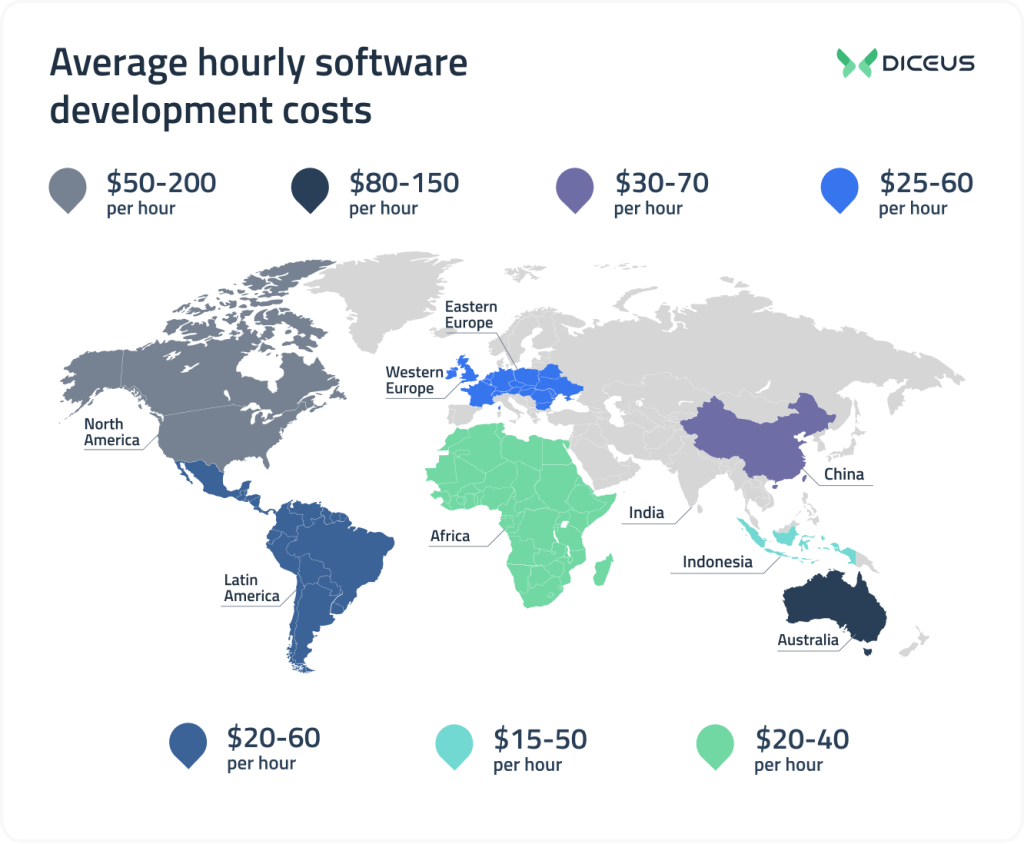

Top 12 factors affecting software development costs in 2024-2025
How much does it cost to develop software? There’s no pat answer. When people try to guess the costs of software engineering, they often look for developers’ hourly rates. Prices nearly always depend on the country where these developers live. Software development costs are unendingly varied across the globe. Find the average software costs in the picture below. However, note that price by location is not the only factor affecting the software project costs.

As you see, North America has the highest rates. It’s not surprising since senior software developers in the US earn about $220,000, which makes it one of the highest-paying jobs in the country. In contrast, Indonesian rates are much lower because of low labor costs and high labor supply.
The point is that compensation for developers’ jobs is not the only aspect defining the software development budget.
Would you like to know the other factors affecting the software cost? Let’s look at the list explaining how various factors influence pricing.
Factor 1 – Artificial intelligence
We’ll start with one of the most popular technology trends that can affect the development price — artificial intelligence. There’s probably no industry that hasn’t been influenced by the appearance of AI. We can’t say that AI has revolutionized software engineering, but it has undoubtedly brought some improvements.
With the advent of ChatGPT, OpenAI Codex, Bing AI, and other AI-based tools, developers searched for and tested various ways of incorporating those into their engineering processes and SDLCs. So, these tools can help in the following:
- Source code generation
- Correcting syntax issues
- Automating unit tests
- Suggestions for code completion
- Minimizing bugs
Overall, all these jobs done with AI-driven tools help developers avoid reinventing the wheel and be more efficient, consequently reducing the time and cost to develop software.
Factor 2 — Type of work
Development from scratch is different from a software upgrade. Imagine your company needs a custom-designed mobile app to engage more customers. At the same time, you want to change your current CRM system for another one. Each task requires different efforts, tech stack, services, and time.
In terms of the IT world, the variety of services mentioned above may sound like this:
- Custom software development
- Legacy system modernization
- Cloud migration
- System integration
- And so on
Just remember, building software from scratch is nearly always more expensive than implementing an out-of-the-box solution, although the first option is more beneficial.
Factor 3 — Type of solutions
Many people consider software development equal to building an app and, thus, speak of application development costs as a benchmark. However, a mobile or web app is only one type of software product.
Other solutions include:
- Content Management Systems (CMS)
- Enterprise Resource Planning (ERP) systems
- Customer Relationships Management (CRM) systems
- Websites (very often e-Commerce ones)
- Core banking systems
- Software as a Service (SaaS) products
Each involves various software development expense levels — from the modest CMS and e-stores (between $20,000 and $50,000) to the big-ticket items like CRM and ERP (up to $600,000).
Factor 4 — Project’s business domain
The other significant factor is the industry where the solution will work. The priciest items are developed for the banking and financial services sectors. The reason for this is the requirement for high-profile security, complexity of development, and level of expertise needed to do engineering jobs for these solutions.
Factor 5 — Project’s complexity and scope
The project’s scope and complexity are related to the number of functionalities, their intricacy, and customization level if it goes about building a new solution. If the project involves upgrading legacy software, a number of changes should be made. When you deal with cloud transformation, you should realize the volume of data to be migrated.
Let’s figurately divide the project into the following four categories:
Small. These are quick to accomplish since they boil down to introducing minor UI tweaks or fixing elementary bugs in existing solutions. As a rule, you can explain what you want, and the IT team will deliver this as soon as possible.
Medium. Here belong primitive apps or sites with a limited number of essential features. It is a project with weekly check-in sessions, clear milestones and deliverables.
Large. Building solutions of this kind requires multiple integrations, dealing with a database component, and tackling security issues. Multi-platform apps are a great example of projects of this type. In this case, the client-vendor interaction is more robust when conducted daily.
Enterprise. Commonly, these projects are based on an underlying framework and presuppose top-notch security measures, logging, and providing data integrity. For instance, a mobile app like Uber. They require a big team working on a solution for quite a long time, regular meetings, and monthly all-hands get-togethers.
It goes without saying the more complicated the project is, the bigger the average software development cost is.
Factor 6 — Platform
It comes into play when you are building a mobile app. Since two operating systems exist today (Android and iOS), you should choose which mobile device it will run on. Of course, you can make it available for both categories. In this case, you will have to create two apps. Why? Each platform-reliant product must be built with different tools and programming languages.
This pricey option of developing two native apps can be countered by cross-platform app development when you build one app to fit both systems. Although considerably cheaper, such apps can’t beat native ones in terms of performance, speed, and UX.
For web apps, the choice of a system (Windows, Linux, or macOS) isn’t critical since Python, JavaScript, and other programming languages utilized to build them are platform-independent.
Factor 7 — UI/UX design
Software products, especially mobile apps, should have user-friendly functionalities and attractive interfaces. Otherwise, people will abandon them almost at once. That is why customers pay much attention to buttons, colors, fonts, and icons, as well as to the foolproof navigation and no-sweat usage.
In-depth customer experience research requires the involvement of a CX researcher who discovers a user journey starting from the first interaction with the company and ending with the last touchpoint. Such research also involves user interviews, customer portraits, and user journey mapping, which adds to the cost of software.
Factor 8 — Back-end
Architecture and know-how inside the gadgets are called to provide what was mentioned in the previous section. Besides, modern software seldom works in isolation, connected to third-party resources and external environments (payment gateways, geolocation, mapping, EHR, etc.). To unite them all into one system, a range of APIs must be employed.
Factor 9 – Integrations
As mentioned above, software products are often connected with APIs, payment gateways, various modules, etc. The need to integrate software also impacts the cost of development. Integration needs should be estimated during the discovery phase, so be sure to inform your team about these requirements.
Factor 10 — Tech stack
The tech stack is probably one of the most important factors defining the cost of software development. Why? The total cost of software includes developers’ salaries. The latter differ depending on the programming language a person is skilled at. For example, according to Stack Overflow’s survey among the top five highest-paid languages in 2023 are the following:
- Zig – $103,611
- Erlang – $99,492
- F# – $99,311
- Ruby – $98,522
- Clojure – $96,381
Besides, these figures may vary as, according to the same survey, median salaries increase each year.
To appeal to a greater audience and upgrade task-solving potential, modern software makes extensive use of state-of-the-art technologies as well. If you want to include BI, AI, ML, blockchain, IoT, or any other latest know-how to enhance your product, be ready to pay a pretty penny for it.
Factor 11 — Testing
Testing is an anchor of software quality. The better the quality assurance is organized, the more confident you may be that the solution will operate seamlessly. The scope of testing is directly proportional to the sum you must fork out for it.
To assess the cost of developing software, consult with test engineers if you need test automation. Except for manual testing, large and complex projects usually require test automation. The involvement of a QA automation engineer will add to the cost of software engineering.
Factor 12 – Team composition
The number of people required to deliver the project depends mainly on the project’s scope. The core team includes a business analyst, several software developers, a UI/UX designer, a tester, and a project manager.
More complex endeavors would necessitate increasing the number of these specialists and enlisting the services of a DevOps engineer, product manager, etc. In this case, the total number of employees on your payroll would grow from 3-4 to a dozen or even more.
Usually, technology partners offer to hire staff according to a seniority-level matrix. The latter shows the developer’s position in the rate card that is conditioned by their skills and experience.
IT staffing services are much more than just hiring the required developers. It’s a complex service that brings lots of added value.
How to estimate software development costs
Many sites offer a cost calculator for custom software development. In our view, using it to fathom your expenditure down to a penny is a bad mistake. Firstly, every project is unique, with too many variables to consider. So, embarking on a calculation endeavor, you will arrive at a ballpark figure at best, which will undergo considerable correction (usually upwards).
Secondly, it makes sense to get down to numbers only when you have selected a vendor. To answer, “How much does a software cost?” we offer a discovery phase. At this preliminary stage, experts map out requirements, the number of hours needed to develop the solution, the required IT team members, and the tech stack to accurately estimate the budget.
Custom software products can be a game-changer for most digitally driven industries. To calculate the software development pricing, consider factors pertaining to the product you will commission and the outsourcer who will implement it.
FAQ
What are the average software development costs?
State-of-the-art software is never chump change; measuring its average cost is like determining the average depth of the seven seas. This means the number may be nowhere near your particular project expenditures. In any case, be ready to fork out at least $50,000.
How to estimate the cost of software development?
Several factors affect the final price tag. They relate both to the characteristics of the project to be implemented (its scope, type, industry, technical features, and testing procedure applied) and to the team that is going to tackle it (its location, composition, engagement model, and period of time it will work at it).
What is the hourly rate for software development?
Rates differ depending on the vendor’s location – starting with $15 in Africa and South Asia to $200 in North America and Western Europe. The optimal numbers are offered in Eastern Europe that, coupled with the high quality of output, make countries of the area (Ukraine, Poland, Romania, the Czech Republic, and others) a perfect outsourcing destination.





